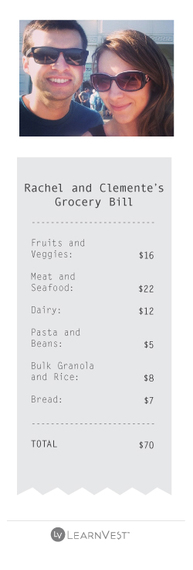Grocery shopping sometimes feels like you're buying a car: Either you marvel at the great deal you got -- or get sticker shock after all the costs are added up.
Complicating matters is that no two grocery budgets are alike. Your spending depends on how big your family is, how willing you are to search for those deep discounts and where you live. How many times have you been traveling, visited the local grocery store and declared, "They pay what for that here?"
So we asked four real families across the country if we could take a peek into their weekly grocery bills to see how much they spend, where they save and what they splurge on. They also shared their grocery game plan with us, telling us how they tackle the weekly chore as a team.

Who: Marissa Vicario, 35, a health coach, and fiancé David McFarland, 42, a sales director. They spend about $180 a week on groceries.
Location: New York City
Our must-haves: David loves Purely Elizabeth granola, and I love tempeh. We make our own salad dressing, so we also invest in good quality coconut and olive oil. We also love leafy greens, ginger and lemons.
We try to buy mostly organic, especially for produce with edible leaves or skin that isn't covered by a rind or peel.
How we save: I grab the store circular to see what's on sale. If something is a two-for-one special, we actually avoid temptation unless it's something we know we'll use.
I love using coupons for items we already buy. David used to think couponing was crazy, but once we saved $10 off our total bill -- now he gets it.
The bulk aisles are great for nuts, grains and dried beans. We also buy our fruit and vegetables in season. Certain things, like bananas, we get a lot of, so we choose non-organic to trim a few dollars off our bill.
We're fortunate to have plenty of space in our kitchen, so we don't feel constrained. That said, we buy only what we need -- if anything, we're a little conservative.
To make our food last longer, we use our freezer for fruits and vegetables and fresh seafood and chicken, as long as they weren't previously frozen. If we have a lot of leftovers, we'll freeze them to be eaten the following week, or we'll eat them for lunch or dinner the next day.
We rarely throw food out. It's one of my pet peeves!
How we shop: David and I usually shop together on Sunday and sometimes on weekday afternoons, when it's less crowded. I've tried grocery shopping online, but can't get into it.
Weekday meals are kept simple. We'll meal plan when we're organized, but frequently, we just wing it. While we use a shopping list, we don't always stick to it -- it really depends on what looks good, what's on sale and what's in season.
David and I shop at our neighborhood Whole Foods in TriBeCa, which is within walking distance. We invested in a wheeled tote, which has paid for itself in all the delivery fees we've avoided!
We've got our routine down to a science. We tend to follow the same path: We shop the outside aisles, starting together in the produce section, and then split up. I'll go to the bulk aisle and David goes to the meat counter.
We also love farmers markets. We belonged to a CSA for a couple of years, but found we couldn't use all the produce before it went bad. If we did it again, we'd share it with another couple. In the meantime, my dream is to have my own vegetable garden!

Who: Melissa Garcia, 38, a blogger, and husband Daniel, 40. They have a daughter, Taylor, 17, and a son, Ryan, 14.
Because Melissa is a coupon blogger at consumerqueen.com, her weekly bill ranges anywhere from $20 to $60, depending on how much of a discount her coupons nab her.
Location: Edmond, Okla.
Our must-haves: Griffin's Syrup, which is the brand I grew up on; Heinz Ketchup -- the only ketchup I'll eat, hands down; and Hiland French Onion Dip. You won't see any other kind in my house!
While I'm not yet fully organic, I try to purchase as much organic as possible. I also look for products that are non-GMO.
How we save: I always use coupons when I can, but I don't let that limit what I buy. My motto is "Save where you can, so you can spend on what you want."
When I find sales on fresh produce and meat, I stockpile them, within reason, in one of my two large upright freezers in the garage. I plan our meals around the contents of my stockpile on a large dry-erase board. This helps me organize what I need to buy and saves me time and money. Despite my best efforts, though, we do occasionally throw food out.
We also have a strawberry patch and just planted a vegetable garden with tomatoes, peppers, cucumbers, cilantro and garlic.
How we shop: I shop with my mom and cousin after church on Sunday. We love shopping together and make it a team effort. We'll attach our coupons to the top of our lists to help stay organized. I also do quick weeknight trips when a new sale starts.
I don't limit myself to just one store, since I shop the deals. I love Homeland because they double coupons and Walmart because they price-match. I rarely shop online, but I've occasionally snagged deals on Amazon.
I also love supporting our farmers market. They don't just carry fresh fruits and vegetables -- I recently picked up some amazing fresh tamales!
 Who: Rachel Jimenez, 26, a COO, and husband Clemente, 26, a CPA. They generally spend $70 to $100 per week on groceries.
Who: Rachel Jimenez, 26, a COO, and husband Clemente, 26, a CPA. They generally spend $70 to $100 per week on groceries.
Location: Rancho Cucamonga, Calif.
Our must-haves: About once a month, we'll buy top-of-the line meat or seafood like crab legs, lobster and shrimp.
And we definitely have to have fresh fruits and vegetables. Our favorites include bananas, apples, zucchini, spinach, avocados, asparagus, broccoli, strawberries, watermelon and mango.
How we save: We use coupons, stock up on sale items that won't go bad quickly like canned goods and sauces, and buy meat and freeze it. Unfortunately, we don't have a large fridge, freezer or storage space in our house, so we can't stock up on too much.
While we buy lots of fruits and vegetables, we don't insist they're organic, and we will buy a few things wholesale if the price is right -- everything from meat to tortillas to paper goods.
Because we have busy schedules, we don't just plan our meals but we also plan how we'll use the leftovers. We'll eat leftovers for lunch at work and occasionally for dinner the next day. Sometimes we'll also plan to use leftovers for different meals; for example, if we make a large roast one night, we'll use the leftover beef to make tacos or taquitos. We occasionally have to toss food, but we try to keep it to a minimum.
How we shop: Clem and I usually shop together on Sunday afternoons on our way home from doing other errands.
We've been meal planning for the four years we've lived together and always have a grocery list. We do our food brainstorming over the weekend while we're getting ready, lounging around or watching TV.
We consider our schedules for the week and decide how many meals we'll be eating at home. Then we think of favorite meals we want to cook -- I keep a running list on my phone. We also look online and in cookbooks for new recipes. We try to balance our proteins and avoid duplicating meals. Once we've decided on our menu, we write a list of all the ingredients we'll need.
We shop at Sprouts, Stater Brothers and Costco. Depending on our list, some weeks we go to only one store; other weeks we'll go to all three. We occasionally head out to the farmers market, and I'll sometimes shop online at worldgardenscafe.com.

Who: Stacy Wirtz, 37, a sales and marketing manager, and husband Daniel, 50, a sales representative. They have two daughters, Isabella, 10, and Madelyn, 6. They spend about $150 per week on groceries.
Location: Helena, Mont.
Our must-haves: Lots of fresh organic fruit from Costco. Our favorites are apples, grapes, nectarines, strawberries, raspberries, peaches, bananas, pineapples and pears. We have fruit in the house year-round, whatever the cost.
RELATED: 7 Clever Summer Fruit Recipes
How we save: We live on five acres and are lucky to have a large kitchen with a pantry and lots of storage space. We're able to buy in bulk and stock up on sale items like toilet paper and paper towels.
To save on meat, we buy a half of grain-fed, hormone-free Montana beef every year for $900 from a nearby butcher. We shell out a lot of cash up front, but it's about half the cost compared with buying individual packages throughout the year. It's one price for hamburger, steak, prime rib, ribs, stew meat and roasts. The beef comes cut and packaged to my specifications, so it lasts longer in our large stand-up garage freezer.
We also buy a quarter hog, which provides chops, ham, bacon, roasts and ribs, for $125 from the same butcher. For variety, we buy chicken in bulk at Costco. We vacuum-pack our meat and cheese, and use FridgeSmart Tupperware containers to keep fruits and vegetables fresh for twice as long. While we occasionally throw food out, the Tupperware allows us to waste less. I just love it!
How we shop: I mainly shop on weeknights, with one night at Costco and another at Walmart. I usually have a grocery list that I try to stick to and get the shopping done quickly.
At Costco, I buy items I know we'll consume before the expiration date. That includes fruits, dairy, eggs, lunch meats, pizza, sauces, crackers and canned vegetables. I'll shop at Walmart for items that we eat less often so I can buy a smaller size.
Occasionally, the whole family shops together on weekends, but then we end up with a lot more impulse purchases, like extra drinks, chips, candy and cookies.
I don't grocery shop online, but we do go to the farmers market for homemade jams and some fruits and vegetables.
This post originally appeared on LearnVest.
More From LearnVest
Grocery Shopping on a Budget: 10 Ways to Keep Rising Food Costs in Check
The One-Number Strategy: A New Approach to Budgeting
How I Saved My Family $600 a Month on Groceries
LearnVest is a program for your money. Read our stories, use our tools and talk to a Planner about getting a financial plan designed for you.
LearnVest Planning Services is a registered investment adviser and subsidiary of LearnVest, Inc. that provides financial plans for its clients. Information shown is for illustrative purposes only and is not intended as investment, legal or tax planning advice. Please consult a financial adviser, attorney or tax specialist for advice specific to your financial situation. Unless specifically identified as such, the people interviewed in this piece are neither clients, employees nor affiliates of LearnVest Planning Services, and the views expressed are their own. LearnVest Planning Services and any third parties listed in this message are separate and unaffiliated and are not responsible for each other's products, services or policies.
